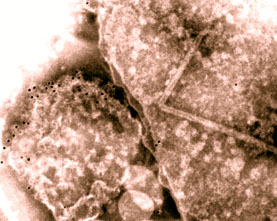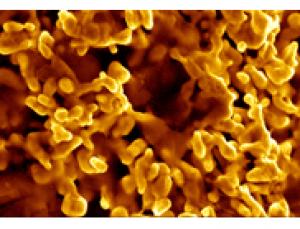Ralstonia metallidurans: Difference between revisions
No edit summary |
No edit summary |
||
| Line 1: | Line 1: | ||
{{Biorealm Genus}} | {{Biorealm Genus}} | ||
[[Image:060718_gold_bacteria_01.jpg|thumb|300px|right|''Ralstonia metallidurans''. [http://images.livescience.com/images/060718_gold_bacteria_01.jpg]]] | [[Image:060718_gold_bacteria_01.jpg|thumb|300px|right|'' Bacterial induced formation of Cd crystals by Ralstonia metallidurans on Zirfon M5 membranes in the continuous tubular membrane reactor.''. [http://images.livescience.com/images/060718_gold_bacteria_01.jpg]]] | ||
| Line 50: | Line 50: | ||
==Cell structure and metabolism== | ==Cell structure and metabolism== | ||
Ralstonia metallidurans uses a variety of substrates as its carbon source or it can grow chemo-lithotropically using molecular hydrogen as the energy source and carbon dioxide as a carbon source. When nitrate is present | Ralstonia metallidurans uses a variety of substrates as its carbon source or it can grow chemo-lithotropically using molecular hydrogen as the energy source and carbon dioxide as a carbon source. When nitrate is present Ralsonia metallidurans can grow anaerobically. | ||
Its optimal growth temperature is 30 çC. | Its optimal growth temperature is 30 çC. | ||
Revision as of 05:45, 3 May 2007
A Microbial Biorealm page on the genus Ralstonia metallidurans

Classification
Higher order taxa
Kingdom: Bacteria Phylum: Proteobacteria Class: Beta Proteobacteria Order:Burkholderiales Family: Ralstoniaceae Genus: Ralstonia Species: R. metallidurans
Species
|
NCBI: Taxonomy |
Ralstonia solanacearum Ralstonia oxalatica Ralstonia paucula Ralstonia pickettii
Genus species
Description and significance
The reference strain of Ralstonia Metallidurans, CH34, was first isolated in 1976 from the sludge of a zinc decantation tank in Belgium that was polluted with high concentrations of several heavy metals, it and other metal-resistant members of the genus Ralstonia are frequently found in sediments and soils with a high content of heavy metals from diverse geographical locations Describe the appearance, habitat, etc. of the organism, and why it is important enough to have its genome sequenced. Describe how and where it was isolated.
Alcaligenes eutrophus CH34, recently renamed Ralstonia eutrophus is a gram-negative, non-spore forming bacterium which thrives in the presence of millimolar concentrations of several heavy-metals; Zn, Cd, Co,Pb,Hg, Ni and Cr.
Ralstonia Metallidurans is better able to withstand high concentrations of heavy metals than any other well-studied organism. This fact renders it a potential agent of bioremediation as well as an ideal model organism for understanding metal resistance phenotypes. Due to its survival in extreme metal concentrations and genomic sequencing it is thought to be one of the first life forms on earth.
Include a picture or two (with sources) if you can find them.
Genome structure
The heavy-metal resistance is conferred by two large megaplasmids (pMOL28=180 kbp and pMOL30=240 kbp) carrying gene clusters that encode cation-efflux machinery spanning both bacterial membranes. These low-copy number plasmids are stably maintained in the presence or absence of selective pressure and are self-transferable at relatively low frequencies Both plasmids are low copy number and stably maintained even without selective pressure. They are self-transferable at low frequencies. The Minimal Inhibitory Concentration (MIC) for free, non-chelated Ni, Co, Zn and Cd are 2.5, 20, 12 and 2.5 mM, respectively for the reference strain.
The genome of this bacterium contains also 8 P-type ATPase involved in metal efflux specialized in lead, cadmium, thallium and/or copper efflux, and several others mechanisms involved in metal processing.
Scientisist have analysed the genome of Rme for genes encoding homologues of established and putative transport proteins; 13% of all genes in Rme encode such homologues. Nearly one-third of the transporters identified (32%) appear to function in inorganic ion transport with three-quarters of these acting on cations. Transporters specific for amino acids outnumber sugar transporters nearly 3 : 1, and this fact plus the large number of uptake systems for organic acids indicates the heterotrophic preferences of these bacteria. Putative drug efflux pumps comprise 10% of the encoded transporters, but numerous efflux pumps for heavy metals, metabolites and macromolecules were also identified.
Cell structure and metabolism
Ralstonia metallidurans uses a variety of substrates as its carbon source or it can grow chemo-lithotropically using molecular hydrogen as the energy source and carbon dioxide as a carbon source. When nitrate is present Ralsonia metallidurans can grow anaerobically. Its optimal growth temperature is 30 çC.
Ecology
Ralstonia (Wautersia, Cupriavidus) metallidurans (Rme) is better able to withstand high concentrations of heavy metals than any other well-studied organism. This fact renders it a potential agent of bioremediation of soil and water contaminated with heavy metals or chlorinated organic compounds as well as an ideal model organism for understanding metal resistance phenotypes.
Lead contamination is a serious threat to human health and the environment. Lead levels are typically measured by using atomic absorption spectroscopy or other related instrumental methods. Developent of fluorescent Lead II Probe from Lead II-regulatory protein isolated from Ralstonia Metallidurans could provide rapid, on-site evaluation of the lead content of a sample.
Pathology
How does this organism cause disease? Human, animal, plant hosts? Virulence factors, as well as patient symptoms.
Application to Biotechnology
Interestingly, enzymes from Ralstonia metallidurans were used by scientists in constructing a fuel cell. By encasing a pair of electrodes coated with these enzymes from Ralstonia metallidurans which oxidize hydrogen put inside a container filled with air and 3 percent more hydrogen . Trials of the fuel cell produced enough electricity to make a watch go! Larger scale productions are thought to be possible are are in the making.
It is also thought that Ralstonia metallidurans is thought to precipitate gold out of solution. It has an ability to survive in gold concentrations that would kill most other organisms.
[[

Current Research
Enter summaries of the most recent research here--at least three required
References
Edited by student of Rachel Larsen and Kit Pogliano
